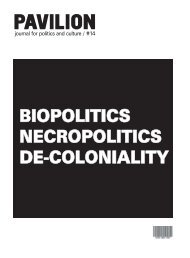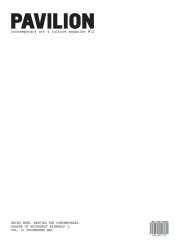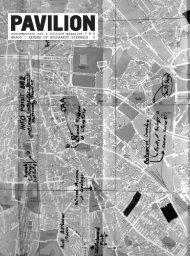Download pdf version of issue no. 16 (4 Mb) - Pavilion
Download pdf version of issue no. 16 (4 Mb) - Pavilion
Download pdf version of issue no. 16 (4 Mb) - Pavilion
Create successful ePaper yourself
Turn your PDF publications into a flip-book with our unique Google optimized e-Paper software.
Vesna Pavlović<br />
Vesna Pavlović (Serbia/US) obtained her MFA<br />
degree in visual arts from Columbia University<br />
in 2007. She is an Assistant Pr<strong>of</strong>essor <strong>of</strong> Art at<br />
Vanderbilt University where she teaches photography<br />
and digital media. She has exhibited<br />
widely, including solo shows at the Frist Center<br />
for the Visual Arts in Nashville, Museum <strong>of</strong><br />
History <strong>of</strong> Yugoslavia in Belgrade, and the<br />
Crocker Art Museum in Sacramento. She has<br />
been featured with a solo presentation at the<br />
Untitled, 12th Istanbul Biennial, 2011, and in<br />
group exhibitions at the Le Quartier Center for<br />
Contemporary Art in Quimper, France (From<br />
Closed World to the Infinite Universe),<br />
Museum <strong>of</strong> Contemporary Art in Belgrade<br />
(Conversations), Serbia, Tennis Palace Art<br />
Museum in Helsinki, Finland (Situated Self,<br />
Consfused, Compassionate, Conflictual),<br />
Photographers' Gallery in London<br />
(Mediterranean, Between Reality and Utopia),<br />
Kettle's Yard in Cambridge, UK (Rear View<br />
Mirror), and FRAC Center for Contemporary<br />
Art in Dunkuerqe, France (De-Collecting).<br />
Vesna Pavlović is the recipient <strong>of</strong> the Robert<br />
Penn Warren Fellowship at Vanderbilt<br />
University, and Copenhagen Artist-in-<br />
Residence grant in 2011. Selected publications<br />
include: Office Taste, co-authored with<br />
Casey Smith, Belgrade, Skart, 2005 and An<br />
Idyll on the Beach, Belgrade, Samizdat, 2001.<br />
Anahita Razami<br />
Anahita Razmi (* 1981, Hamburg / Germany)<br />
is a video and performance artist.<br />
Her works <strong>of</strong>ten are dealing with <strong>issue</strong>s concerning<br />
identity and gender, employing objects<br />
with a national and cultural significance or citing<br />
the work <strong>of</strong> high-pr<strong>of</strong>ile artists. Working<br />
within the tradition <strong>of</strong> appropriation and reenactment,<br />
Razmi detaches cultural symbols<br />
from their established meanings by employing<br />
them in unexpected situations and contexts.<br />
Within this, her work <strong>of</strong>ten builds up a relation<br />
to contemporary Iran. Recent solo and group<br />
shows include "Videonale 13", Kunstmuseum,<br />
Bonn, Germany (2011), "Division by Zero",<br />
Carbon12, Dubai (2011), "Iran Via Video<br />
Current", Thomas Erben Gallery, New York<br />
[198]<br />
(2011), "Make - Believe - Remake",<br />
Kunstverein Friedrichshafen, Germany (2011),<br />
"The State: Social? Antisocial?", Traffic, Dubai<br />
(2011), "Leinen Los!", Kunstverein Han<strong>no</strong>ver<br />
(2010), „Ikeallahu Akbar“, Interventionsraum,<br />
Stuttgart (2010), "Robberies", Kunstverein Das<br />
Weisse Haus, Wien (2010). In 2010 Razmi<br />
received a work stipend from the Edith Russ<br />
Site for Media Art, Germany for her work "The<br />
Paykan Project", in 2011 she was awarded<br />
"The Emdash Award" (Frieze Foundation,<br />
London) for her project "Ro<strong>of</strong> Piece Tehran".<br />
Wael Shawky<br />
Wael Shawky is born in 1971 in Alexandria,<br />
Egypt, studied visual arts in Egypt and the US.<br />
Recent solos have taken place at Nottingham<br />
Contemporary (2011) and Cittadellarte-<br />
Fondazione Pistoletto (2010). Shawky has<br />
participated in Istanbul Biennale (2011) and<br />
(2005), The Santa Fe Biennial (2008) and the<br />
Biennial di Venizia (2003). Recent awards<br />
include the Schering Foundation Art Award<br />
(2011) and Abraaj Capital prize (2011).<br />
Shawky founded MASS Alexandria, educational<br />
space (2010)<br />
Alexandre Singh<br />
Alexandre Singh is a visual artist and writer<br />
based in New York. Singh who was born in<br />
Bordeaux, France to Indian and French parents<br />
was brought up in Manchester, UK before<br />
studying Fine Art at the University <strong>of</strong> Oxford,<br />
UK. Singh’s work derives at once from traditions<br />
in literature, performance, photo-conceptualism<br />
and object-based installation art. Often<br />
starting with elaborate, publicly presented lectures<br />
that blend historical fact with narrative<br />
fiction, Singh’s practice resists categorization.<br />
Taking in such diverse genres as writing, collage,<br />
installation and performance, Alexandre<br />
Singh’s works are characterized by obsessive<br />
details and linkages. Drawing upon a dizzying<br />
constellation <strong>of</strong> themes and characters; culled<br />
as much from classical history and philosophy,<br />
as popular and consumer culture; Singh’s universe<br />
is one <strong>of</strong> absurdist junctures and juxtapositions<br />
in which Adidas founder Adi Dassler<br />
is re-imagined as Faust; Piero Manzoni creates<br />
a camera that eats the Universe; and<br />
Molière’s send-ups <strong>of</strong> 17th century s<strong>no</strong>bbery<br />
are translated to modern-day New York. If figures<br />
such as Molière, Lucian <strong>of</strong> Samosata,<br />
and even Woody Allen, appear as characters<br />
in Singh’s world, it only seems natural, his<br />
works perpetuating a like spirit <strong>of</strong> wit, imagination<br />
and fantasy.<br />
Alexandre Singh's work has been exhibited in<br />
venues throughout Europe and the United<br />
States including The Serpentine Gallery,<br />
London; New Museum, New York; PS-1<br />
MoMA, New York ; Stedelijk Museum,<br />
Amsterdam; Palais de Tokyo, Paris and Sprüth<br />
Magers, Berlin. Singh’s work is held by a number<br />
<strong>of</strong> private and public collections including<br />
MoMA, New York and the Solomon R.<br />
Guggenheim Museum, New York.<br />
Mounira Al Solh<br />
Born in Beirut in 1978 Al Solh studied painting<br />
at the Lebanese University in Beirut (LB), and<br />
Fine Arts at the Gerrit Rietveld Academy in<br />
Amsterdam (NL). In 2007/08, she was a resident<br />
artist at the Rijksakademie in Amsterdam.<br />
Her work is playfully conceptual, and includes<br />
videos, installations, magazines, drawings and<br />
performances, while it “queries the possibilities<br />
and impossibilities <strong>of</strong> roles accessible to contemporary<br />
artists, and their impact in a globalized<br />
consumer culture. The experience is – to<br />
say the least – schizophrenic. And thus comes<br />
in the voice-overs, role-play, invented personas<br />
(such as Bassam Ramlawi) and dressing-up,<br />
as characteristic <strong>of</strong> her practice. More<br />
<strong>of</strong>ten than <strong>no</strong>t, Al-Solh does <strong>no</strong>t provide an<br />
answer but keeps pushing questions.” (By Nat<br />
Muller)<br />
Thus, “gray humor” is recurrent in her work<br />
and while starting from the autobiographical<br />
she proposes specific socio-political and aesthetic<br />
questions, where the futile becomes the<br />
essence. She <strong>of</strong>ten reflects on specific artworks<br />
including them into her fictions and<br />
invented stories that are finally neither so fictional<br />
<strong>no</strong>r really invented.<br />
Rinus Van de Velde<br />
Rinus Van de Velde (°1983) lives and works in<br />
Antwerp. His practice mainly consists <strong>of</strong> drawings<br />
that hearken back to a personal archive <strong>of</strong><br />
photographs derived from vulgarizing scientific<br />
magazines such as National Geographic, from<br />
biographies <strong>of</strong> artists and scientists... Lately,<br />
he <strong>of</strong>ten re-enacts found footage or even<br />
stages <strong>no</strong>n-existent scenes in photographs,<br />
which he then uses as source material.<br />
Van de Veldes overtly narrative drawings are<br />
confronted with texts in installations that tell a<br />
new and personal story. This fiction takes<br />
place in a mirror universe that is peopled by<br />
courageous alter egos and who serve as ideal<br />
representatives <strong>of</strong> the actual artist. At the<br />
same time, this drawn world is delineated by<br />
its own subjectivity: it can be <strong>no</strong>thing but a fantasy,<br />
a fiction, and so beyond its borders lies<br />
the great <strong>no</strong>thingness <strong>of</strong> the “real” world.<br />
As such, Van de Velde moves through the borderland<br />
between system and unsystematic<br />
reality, between self and ideal, between the<br />
ordinal subdivisions <strong>of</strong> the I and the Other. His<br />
artistic practice is characterized <strong>no</strong>t only by a<br />
personal desire for self-actualization, control<br />
and structure, but also “shows” us something;<br />
namely, that fiction and reality need and even<br />
imply each other.<br />
[199]








